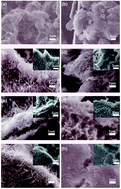Construction of a stable lithium sulfide membrane to greatly confine polysulfides for high performance lithium–sulfur batteries†
Abstract
A stable lithium sulfide membrane is constructed in situ to wrap the mixed sulfur/C material surface of a lithium–sulfur battery (LSB) by delicately tuning the galvanostatic discharge current. The membrane offers unique and selective channels which allow only ions/small sulfides to pass through and confine polysulfide transport, restricting the shuttle effect, and thus providing a large capacity of 685 mA h g−1 at 1C and a long-lasting cycling stability (0.03% capacity decay per cycle). This LSB, which is much superior to the same sulfur-loaded battery without the membrane (0.26% capacity decay per cycle over 207 cycles and 213 mA h g−1 at 1C), is the best among all reported plain carbonaceous host material-based LSBs. The mechanism responsible for such dramatically improved performance is discussed in detail. This work not only offers a facile approach to greatly improve the capacity and stability of LSBs for practical applications but also offers new scientific insights into LSB design.



 Please wait while we load your content...
Please wait while we load your content...